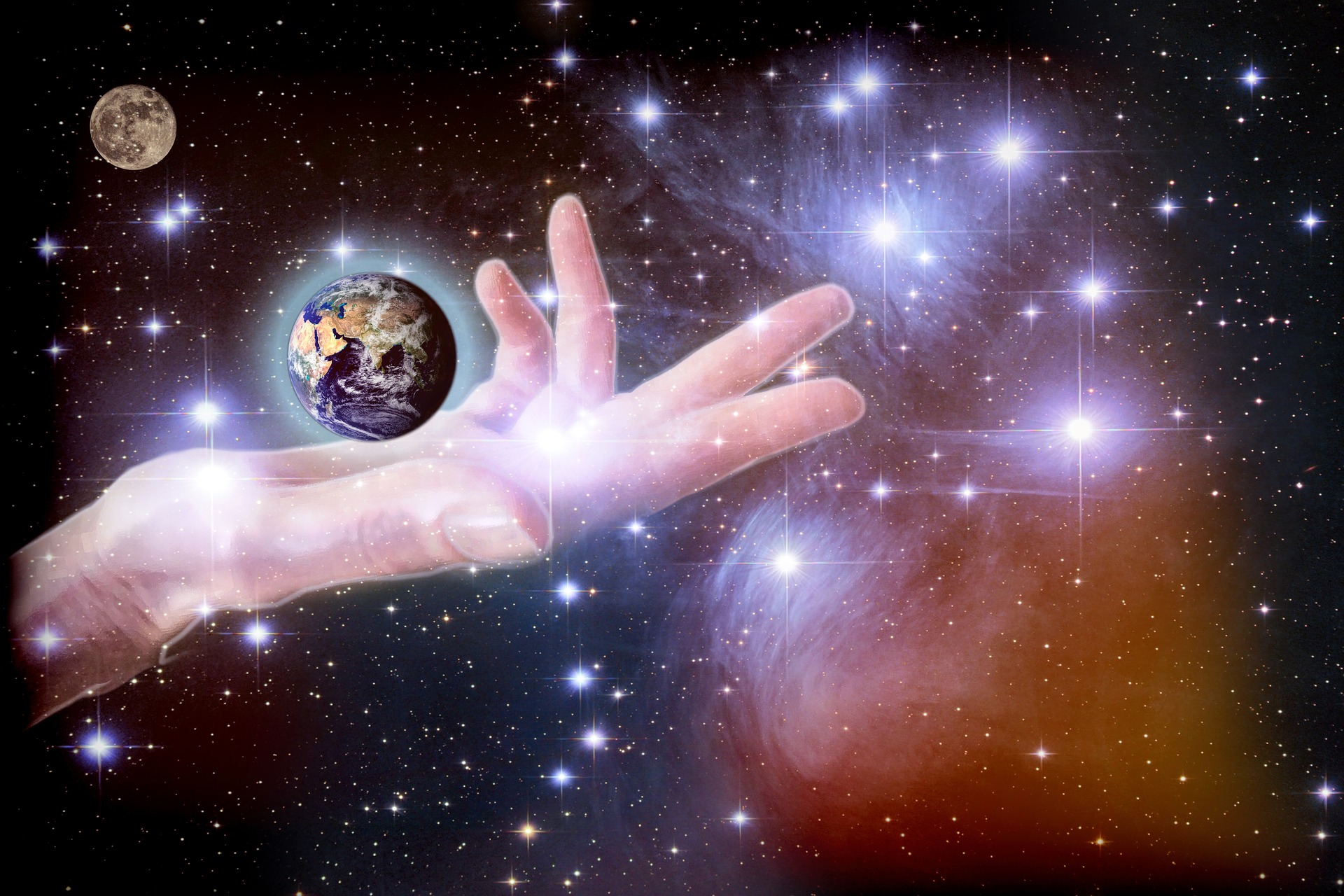 Submitted by Dr. Aadesh Kumar on
Submitted by Dr. Aadesh Kumar on

by Vatsal Teraiya (Information and Communication Technology, DAIICT)
Modern science tells that universe began around some 13 billion years ago, where there was nothing before big bang, it came out from zero, even time also popped out at that instance.
While Hindu's cosmology says, there is repetitive cycle of big bang and followed by big crunch, which is particularly for one universe. while you are reading this there is continuously big bang and big crunch happening somewhere in hyperspace. so our universe is one of those universes which had big bang and will terminate by big crunch, with repeated endless cycles...welcome to multiverse
BASICS:
In Hindu cosmology, the universe is cyclically created and destroyed.[1] Deeply rooted in the texts of Hindu literature, including the Vedas and the Puranas, is the belief time is divided into four epochs or Yuga, of which we occupy the final. In roughly 432,000 years, it is believed that the Avatar Kalki, the final incarnation of Vishnu, will bring the end time (i.e. a time of climax of world events).
Hindu cosmology also describes aspects of evolution, astronomy, and astrology.
Rig Veda
The Rig Veda speculates about the origin of the cosmos: "Neither being (sat) nor non-being was as yet. What was concealed? And where? And in whose protection?…Who really knows? Who can declare it? When was it born, and when came this creation? The devas were born later than this world's creation, so who knows from where it came into existence? None can know from where creation has arisen, and whether he has or has not produced it. He who surveys it in the highest heavens, He alone knows-or perhaps does not know." (Rig Veda 10. 129)[11]
The Rig Veda's view of the cosmos also sees one true divine principle self-projecting as the divine word, Vaak, 'birthing' the cosmos that we know, from the monistic Hiranyagarbha or Golden Womb. The universe is considered to constantly expand since creation and disappear into a thin haze after billions of years. An alternate view is that the universe begins to contract after reaching its maximum expansion limits until it disappears into a fraction of a millimeter. The creation begins anew after billions of years (Solar years) of non-existence.
The Nasadiya Sukta of the Rig Veda describes the origin of the universe. The Rig Veda's view of the cosmos also sees one true divine principle self-projecting as the divine word, Vaak, 'birthing' the cosmos that we know, from the monistic Hiranyagarbha or Golden Egg.[12] The Universe is preserved by Vishnu (The God of Preservation) and destroyed by Shiva (The God of Destruction). These three constitute the holy trinity (Trimurti) of the Hindu religion. Once the Universe has been destroyed by Shiva, Brahma starts the creation once again. This creation-destruction cycle repeats itself almost endlessly as described in the section above on Brahma, Manu and the Yugas.
The Puranas
The later Puranic view asserts that the Universe is created, destroyed, and re-created in an eternally repetitive series of cycles. A day of Brahma, the creator, endures for about 4,320,000,000 years.[1] At this point, Brahma rests for one night, just as long as the day. This process, named Pralaya (Cataclysm), repeats for 100 Brahma years (36,000 days and 36,000 nights of Brahma; 311 trillion, 40 billion human years) that represent Brahma's lifespan as well as that of the universe. Shiva then destroys all existence while creating a new existence, and then time starts over. After Brahma's "death", it is necessary that another 100 Brahma years pass until he is reborn and the whole creation begins anew. This process is repeated ad infinitum.
Brahma is the creator but not necessarily regarded as God in Hinduism because there are said to be many creations. Instead, he is regarded as a creation of the Supreme God or Para Brahman.
We are currently believed[13] to be in the 51st year of the present Brahma's life and so about 158.7 trillion years have supposedly elapsed since the birth of Brahma.
Brahma's day is divided in one thousand cycles (Maha Yuga, or the Great Year). Maha Yuga, during which life, including the human race appears and then disappears, made of 14 Manvantarahas each has 71 divisions. Each Maha Yuga lasts for 4,320,000 years. Manvantara is Manu's cycle, the one who gives birth and governs the human race.
Each Maha Yuga consists of a series of four shorter yugas, or ages as described earlier. The degree of happiness, prosperity and righteousness progressively decays as one proceeds from one yuga to another. Each yuga is of shorter duration than the age that preceded it. The current Kali Yuga (Iron Age) began at midnight 17 February / 18 February in 3102 BC in the proleptic Julian calendar. (Year 6898 of the Holocene Era.)
Only some Puranas describe a universe that is cyclical or oscillating and infinite in time. The universe is described as a cosmic egg that cycles between expansion and total collapse. It expanded from a concentrated form — a point called a Bindu. The universe, as a living entity, is bound to the perpetual cycle of birth, death, and rebirth.
The Padma Purana discusses the number of different types of life-forms in the universe. According to the Padma Purana, there are 8,400,000 life-form species, 900,000 of which are aquatic ones; 2,000,000 are trees and plants; 1,100,000 are small living insects species; 1,000,000 are birds; 3,000,000 are beasts and reptiles; and 400,000 are mammal species. [14]
In the Puranas, and already in the Atharvaveda, there are fourteen worlds, seven higher ones (Vyahrtis) and seven lower ones (Pātālas), viz. Bhuloka, Bhuvar Loka, svarga, Mahar Loka, Jana Loka, Tapa Loka, and Satyaloka above and Atala, Vitala, Sutala, Rasaataala, Talatala, Mahaatala, Patala and naraka below.
The scholar Deborah Soifer describes the development of the concept of lokas as follows:
"The concept of a loka or lokas develops in the Vedic literature. Influenced by the special connotations that a word for space might have for a nomadic people, loka in the Veda did not simply mean place or world, but had a positive valuation: it was a place or position of religious or psychological interest with a special value of function of its own.
Hence, inherent in the 'loka' concept in the earliest literature was a double aspect; that is, coexistent with spatiality was a religious or soteriological meaning, which could exist independent of a spatial notion, an 'immaterial' significance.
The most common cosmological conception of lokas in the Veda was that of the trailokya or triple world: three worlds consisting of earth, atmosphere or sky, and heaven, making up the universe."[15]
# 14 Lokas
01 Satya-loka
02 Tapa-loka
03 Jana-loka
04 Mahar-loka
05 Svar-loka
06 Bhuvar-loka
07 Bhu-loka
08 Atala-loka
09 Vitala-loka
10 Sutala-loka
11 Talatala-loka
12 Mahatala-loka
13 Rasatala-loka
14 Patala-loka
Multiverse in Hinduism
The concept of multiverses is mentioned many times in Hindu Puranic literature, such as in the Bhagavata Purana (400–1000 CE):
Every universe is covered by seven layers — earth, water, fire, air, sky, the total energy and false ego — each ten times greater than the previous one. There are innumerable universes besides this one, and although they are unlimitedly large, they move about like atoms in You. Therefore You are called unlimited (Bhagavata Purana 6.16.37)
After separating the different universes, the gigantic universal form of the Lord, which came out of the causal ocean, the place of appearance for the first puruṣa-avatāra, entered into each of the separate universes, desiring to lie on the created transcendental water (Bhagavata Purana 2.10.10)
The number of universes seems to be uncountable, immeasurable, or incalculable according to the Puranic literature:
Even though over a period of time I might count all the atoms of the universe, I could not count all of My opulences which I manifest within innumerable universes (Bhagavata Purana 11.16.39)
Analogies to describe multiple universes also exist in the Puranic literature:
What am I, a small creature measuring seven spans of my own hand? I am enclosed in a potlike universe composed of material nature, the total material energy, false ego, ether, air, water and earth. And what is Your glory? Unlimited universes pass through the pores of Your body just as particles of dust pass through the openings of a screened window (Bhagavata Purana 10.14.11)
Because You are unlimited, neither the lords of heaven nor even You Yourself can ever reach the end of Your glories. The countless universes, each enveloped in its shell, are compelled by the wheel of time to wander within You, like particles of dust blowing about in the sky. The śrutis, following their method of eliminating everything separate from the Supreme, become successful by revealing You as their final conclusion (Bhagavata Purana 10.87.41)
The layers or elements covering the universes are each ten times thicker than the one before, and all the universes clustered together appear like atoms in a huge combination (Bhagavata Purana 3.11.41)
Yoga Vashishtha, the text which states conversations between Vashistha, a rig vedic teacher, and various Gods and Kakbhusundi, a creature which stands outside of normal time and sees all. It recounts the cyclical nature of time, where Kakabhushundi has seen Ramayan 11 times with different outcomes and seen Mahabharat 16 times with different results, but, after seeing Daksha Yagya twice, he did not either care to see it again or saw no point to seeing any more, as it ended the same way each time.
https://ipfs.io/ipfs/QmXoypizjW3WknFiJnKLwHCnL72vedxjQkDDP1mXWo6uco/wiki/Hindu_cosmology.html
1 2 Dick Teresi. Lost Discoveries: The Ancient Roots of Modern Science--from the Baby. SimonandSchuster. p. 174.
Harry Oldmeadow (2007). Light from the East: Eastern Wisdom for the Modern West. World Wisdom. p. 273. ISBN 9781933316222.
Sushil Mittal, Gene Thursby (2012). Hindu World. Routledge. p. 399. ISBN 9781134608751.
Andrew Zimmerman Jones (2009). String Theory For Dummies. John Wiley & Sons. p. 262. ISBN 9780470595848.
Maharishi Mahesh Yogi on the Bhagavad Gita Translation and Commentary, Arkana, 1967 p. 253
https://books.google.com/books?id=QIvnxhasdGoC&pg=PA6&dq=hindu+cosmology&lr=&ei=g23qSeXaOIG4M9Sz6OkN#PPA8,M1 Time Scales and Environmental Change, Chapman and Driver, p.8
1 2 Maharishi Mahesh Yogi on the Bhagavad Gita Translation and Commentary, Arkana, 1967 p. 254
Maharishi Mahesh Yogi on the Bhagavad Gita Translation and Commentary, Arkana, 1990 p. 254
Maharishi Mahesh Yogi on the Bhagavad Gita Translation and Commentary, Arkana, 1967 p. 253
Brodd, Jefferey (2003). World Religions. Saint Mary's Press. ISBN 978-088489-725-5.
"Upanishads: Gateways of Knowledge", p. 10, by M. P. Pandit, publisher = Lotus Press
The Philosophy of Guru Nanak, Ishar Singh, 1985, p.134
"Religion past and present", p. 516, by Hans Dieter Betz, 2008
Singh, T D; Hinduism and Science
↑ Soiver, Deborah A., The Myths of Narasimha and Vamana: Two Avatars in Cosmological Perspective State University of New York Press (Nov 1991), ISBN 978-0-7914-0799-8 p. 5
- 1266 reads